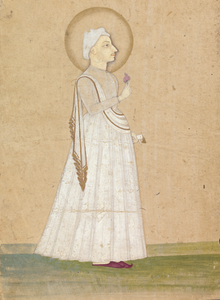Madhavrao Peshwa
|
Shreemant Peshwa Madhavrao Peshwa Ballal |
|
|---|---|

Portrait of Pradhanpant Shreemant Madhavrao Ballal Peshwa at the Yale Center for British Art
|
|
|
|
|
|
In office June 23, 1761 – November 18, 1772 |
|
| Monarch | Ramaraja |
| Preceded by | Balaji Baji Rao |
| Succeeded by | Narayanrao Peshwa |
| Personal details | |
| Born | February 14, 1745 Savnur |
| Died | November 18, 1772 Theur |
| Nationality | Indian |
| Religion | Hinduism |
Madhav Rao I(or Pantpradhan Shrimant Madhavrao (Ballal) Peshwa I a.k.a. Thorle Madhav Rao Peshwa) (February 14, 1745 – November 18, 1772) was the fourth Peshwa of the Maratha Empire. During his tenure, the Maratha empire recovered from the losses they suffered during the Third Battle of Panipat, a phenomenon known as Maratha Resurrection. He is considered one of the greatest Peshwas in Maratha history.
Madhavrao was second son of Nanasaheb Peshwa. He was born in Savnur in 1745. At the time of his birth, Maratha Empire was stretched across a sizeable portion of Western, Central and Northern India. On December 09, 1753, Madhavrao married Ramabai in Pune.
Nanasaheb had greatly expanded the Maratha Empire and had tried to establish better governance. However, he was held partially responsible for the severe defeat of the Marathas by Ahmad Shah Abdali at the Third Battle of Panipat(January 14, 1761). The Marathas suffered heavy losses including Nanasaheb's eldest son and heir Vishwasrao and cousin Sadashivrao Bhau. Unable to bear the suffering, he died of depression on June 23, 1761 at Parvati in Pune.
After his father's death, the sixteen-year-old Madhav Rao was made the next Peshwa of Maratha Empire. His father's brother Raghunathrao was to act as regent.
At the ascendancy of Madhavrao, the Maratha empire was in complete shambles as their defeat at Panipat had accumulated big debts to their wealth. At Shaniwar Wada, the prime residence of Peshwa, religious rituals and ceremonies were frequently being conducted. The discipline required for the smooth running of administrative affairs was almost non-existent. The security at the treasury was poor. When these weaknesses were brought to Madhavrao’s notice and he introduced changes by personally looking into the administration, accounts and the treasury. He also reduced the religious practices being followed at Shaniwar Wada.
...
Wikipedia
